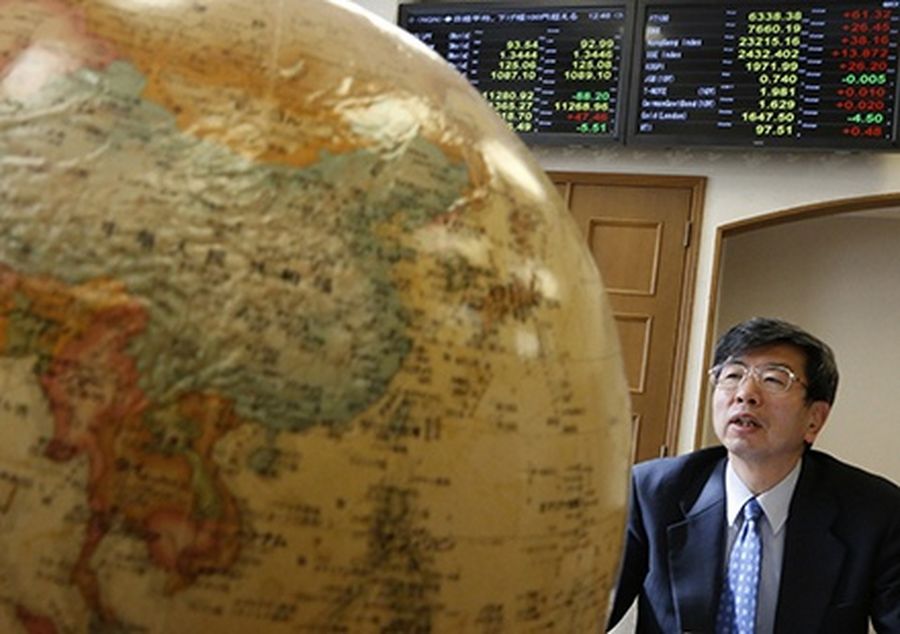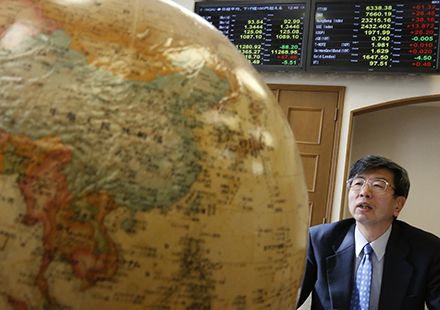Takehiko Nakao, installed as president of the Asian Development Bank 12 months ago, says the bank needs to make its capital as well as its operations more efficient to remain relevant in a growing region.

VIEW FROM THE TOP
Source: REUTERS/Toru Hanai
Takehiko Nakao, president of the Asian Development Bank, speaks during an interview with Reuters at Tokyo’s finance ministry in February 2013.
Takehiko Nakao was confirmed as president of the Asian Development Bank in the days before of the 2013 annual meetings, taking over from the Bank of Japan-bound Haruhiko Kuroda. Like his predecessor, he speaks knowledgeably about the broad Asian region and has a pragmatic view on the ADB’s evolving mandate.
Of ADB’s 48 regional members, 40 are already classified as “middle income”, and some are now attaining investment-grade ratings after recent upgrades to the Philippines and Indonesia. The challenge for Nakao is helping those countries progress towards more advanced income levels with the ADB’s finite resources.
“They can finance themselves by issuing bonds without coming to us. In the past, there weren’t so many sources for them to finance projects, but, today, they can do it,” he said. “So, unless we have some knowledge to share, or some strength for client countries, we are becoming less important, less relevant.”
The ADB’s own capital resources are never going to be large enough for the task at hand: infrastructure-funding requirements in the region alone amount to US$8trn a year, according to the ADB. By leveraging its resources, however, the bank has been able to support priority projects under a strategy the former president termed “finance plus plus” – direct funding, plus leverage, plus knowledge.
Rather than asking the ADB’s shareholders for more money barely five years after the last capital increase, Nakao, Japan’s former vice finance minister for international affairs, has proposed an innovative solution to strengthen the bank’s own capital and make its operations more efficient.
“We want to keep our relevance by keeping our strong capacity for lending and, to have that, we need capital resources,” he said. “In the past, our Triple A rating came from the callable capital guaranteed by the shareholding countries, but many of those, including the US and Japan, are no longer Triple A. So, our Triple A status, which is important for financing our lending at a cheaper rate, needs a stronger equity base.”
The ADB does not face an immediate risk of a downgrade. Fitch Ratings affirmed its AAA call in November, noting that the benefits of a 200% capital increase agreed to in 2009 were still filtering through, with final instalments due from shareholders in 2015.
Discussions on boosting capital, however, are no different from the conversations that have been going on in the boardrooms of countless commercial banks worldwide.
“We cannot continue to ask for bigger contributions from donor countries when they have to contribute to global climate funds and their own financial positions are not that strong. We have to be innovative.”
The transition to Basel III standards has forced all private-sector lenders to review their capital adequacy ratios and, as a result, many have issued additional capital. For the ADB, however, one solution may be to avoid asking governments for additional equity.
“Our lending is totally financed by our funding in the bond market, based on the Triple A rating,” said Nakao. “One interesting idea can be to combine the ordinary capital resources with the Asian Development Fund.”
The ADF was set up over 40 years ago as a separate pool for concessional financing – direct grants and low-interest loans – for Asia’s poorest countries, with the ADB as the administrator. Since the fund was set up, over US$50bn has been allocated, including US$15.5bn during 2009–13.
“The ADF is used to lend, but it is not leveraged in any way,” said Nakao. “It was established in 1972, when the economic power of the donor countries was so superior to the member countries, we couldn’t leverage it. Today, our lending capacity to those countries is falling, and we need to replenish that ADF capital every four years in a very large amount.”
Nakao is proposing a reclassification of the ADF funds to combine them with the ADB’s ordinary capital resources, rather than holding them in a separate trust fund. The concessionary funds will still be ring-fenced for grants and donations to eligible nations, but the move will also allow the ADB to improve its own lending capacity, while the leverage will potentially magnify the impact of the ADF.
“In my view, this is a better use of our equity,” Nakao said. “We cannot continue to ask for bigger contributions from donor countries when they have to contribute to global climate funds and their own financial positions are not that strong. We have to be innovative.”
Nakao is quick to say that the idea is not to expand the ADB’s lending significantly, since the funds will remain tied to concessionary activities. Such a move, however, will be transformational for the ADB. With about US$32bn available, the ADF is around twice the size of the ADB’s own liquidity position, dramatically reducing the need for any additional capital injection.
It is also likely to be popular among ADF donor countries, such as Japan, the biggest contributor to the fund. Japan alone has given more than US$10bn to the ADF, as well as US$900m to the Japan Special Fund, US$335m to the Technical Assistance Special Fund and US$203m to finance the ADB Institute, as of 2012.
“I’m not saying the primary reason is to reduce the burden on the donors, but to continue to support the poorest countries and, to have a strong preparedness for our ADB operations, we need a stronger equity base. If it is combined, we have room for expanding the ADF operations.”
Mid-term report
Nakao’s drive to improve efficiency stretches beyond the ADB’s capital base. Last year’s mid-term review of the ADB’s key mission statement, known as Strategy 2020, identified a number of areas for improvement.
“(Strategy 2020) was published in 2008, but, since then, so many things have happened in the global economy – a financial crisis, typhoon Yolanda, tsunami in Japan and, also, we have seen continued relatively strong growth from Asia. Poverty reduction has progressed, but there are still remaining challenges,” Nakao said.
“Many client countries complain that our processes are sometimes too slow, and our money is more limited than what they need. There are many things we can improve, especially procedures and procurement,” he added.
The ADB relies on exhaustive due diligence to ensure the projects it supports are appropriate and free from corruption. Those steps, however, often lead to criticism that the bank takes too long to approve basic projects or places too great a burden on the borrower.
Nakao aims to introduce a more risk-based approach to due diligence, where the bank spends more time and resources analysing the biggest projects, and hopes to turn those criticisms into an advantage.
“Safeguards should be a key part of our service – not just to keep our integrity, or to avoid any misuse of the money, but also safeguards for environment and social issues should be on the agenda for our client countries. If we can provide a better way of addressing those concerns it should be a service.”
The ADB board is due to approve the final report from the Strategy 2020 review on April 23, but a preliminary presentation calls for a “sharpening and realigning of operational focus” through 10 strategic priorities for 2014–20.
Recommendations include a more rational approach to business processes to deliver value for money, and a more efficient institutional structure to reduce transaction costs and improve staff skills, in part by giving greater power to regional missions.
Nakao’s push for greater efficiency sits awkwardly with the ADB’s track record in producing reams of theoretical research, and some of the bank’s knowledge-focussed initiatives are likely to be scaled back. Efforts to improve the development impact of the ADB’s activities through advisory services to member governments are a good fit, however.
“One of the strengths of the ADB is we can combine finance with knowledge, and our capability of mobilising other resources,” said Nakao. “So, although knowledge work or TA [technical assistance] work can stand alone, our basic work should be combining knowledge with other services – financing remains the most important part of that.”
Technical assistance projects include advising governments on the legal frameworks necessary for public-private partnerships, one of the ADB’s preferred means of leveraging on its own resources with private sector funds, such as power tariffs or renewable energy technology.
“Those are basically for implementing projects and determining the basis for our loans: if we can improve the capacity of the member country, then we can also support with financing,” said Nakao.
While the ADB has no ambitions to emulate the International Monetary Fund in tying lending to conditions, Nakao believes there is an opportunity to influence policy across the region.
“We have a lot of knowledge, a lot of information about the successes and failures of other developing countries and the developed ones like social security systems,” he said.
“Many advanced economies are facing problems with the social security systems, pension systems and health because their assumptions about population growth, and interest rates, have been all wrong. Many policymakers were very optimistic when they designed a health system and a medical system. They expected a 6% interest return on the pensions, but it didn’t happen. People are living much longer and we have a smaller working population,” he added.
Asia has the potential to generate 50% of the world’s GDP by 2050, but the region will need stronger policies to avoid falling into the middle-income trap, says Nakao. Aside from macroeconomic improvements, measures to limit corruption, improve the environment, ensure open trade and investment and better education are all priorities in the shift to a higher-income bracket.
Ensuring that all the region’s governments follow the right recipe is a tall order for a relatively small institution like the ADB – even if Nakao succeeds in expanding its capital base. A year into the role, however, the ADB president is confident member governments want to learn from others’ mistakes.
“I strongly believe that developing countries have a natural advantage in coming late,” he said.
To see the digital version of this report, please click here.
